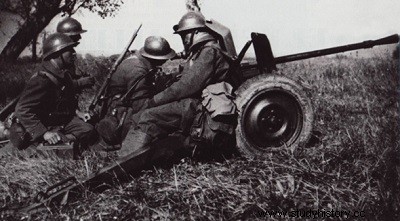
Type Anti-tank gun
Ammunition 25 x 193.5 mm R
Period of use 1934
Service life 1934-1945
Weights and dimensions
Mass (unloaded) 480 kg
Technical specifications
Maximum range 1,000 m
Practical range pierces 50 mm of armor at 600 m
Rate of fire 15/20 rounds/min.
Initial speed 918 m/s
The light 25 anti-tank gun SA-L model 1934 is a French anti-tank gun, built by the gunsmith Hotchkiss. It was used by the French army during the Second World War.

Development
In the early 1920s, the French army became aware of the insufficient performance of the 37 mm TRP. This one, provided in the infantry units, is not able to pierce the armor of the tanks that the potential enemies of France are likely to align during a close conflict. In 1926, Hotchkiss proposed a weapon project, chambered in 25 mm, developed by his design office. This model was accepted in 1934 under the name of the 25 mm semi-automatic model 1934 gun, quickly abbreviated to the 25 mm gun.
Employment
In battle
At the outbreak of the Second World War, the light 25 anti-tank gun SA-L model 1934 equips the support units of the French army, within its infantry. It is the main anti-tank weapon available. A line infantry regiment theoretically has twelve anti-tank guns.
Abroad
Wehrmacht soldiers using a 2.5-cm-PaK 113(f), name given in Germany to the 25 model 1937 gun.
When it arrived in France at the end of 1939, the British Expeditionary Force lacked anti-tank weapons of the order of the Ordnance QF 2 pounder. 25 guns are supplied to the British, which take the name of Anti-Tank Gun, 25 mm. Hotchkiss, Mark I on 25mm. Carriage, Mark I.
Having fallen in large numbers into German hands after the defeat of 1940, the gun returned to service with the Wehrmacht as the 2.5-cm-PaK 113(f), with the (f) for französische (" French"). The guns of the fortress version are often dismantled from the Maginot line to go and garnish the coastal defenses of the Atlantic Wall or the Channel Islands. A few copies also passed into the hands of the Italians, who used them in North Africa as an alternative to the Solothurn S-18/1000.
During the Winter War, Finland purchased 50 examples of the APX SAL 37 through Aladar Paasonen, but only 40 of them were delivered in February 1940. The other ten, in transit in Norway , were captured by the Germans during their invasion of the country in the spring of 1940. Of those who reached Finland, about half served on the front line, where three were destroyed by Soviet forces. During the Great Truce, the Germans sold 200 specimens captured in Finland, including 133 model 1934 and 67 model 1937. They respectively received the denominations of Kanuuna 25 PstK/34 and Kanuuna 25 PstK/37, and sometimes bore the nickname of Marianne. They then served in the Continuation War, until their complete withdrawal in 1943.
In 1935, a few examples were purchased by the US Army for testing.
Versions
Light gun of 25 anti-tank SA-L model 1934
Basic model.
25 mm AC cannon model 1934
So-called fortress version, adopted to equip the Maginot line. The 25 mm gun was not used alone but as a mixed weapon. For this, it was associated with a pair of Reibel machine guns sharing the same ball joint in a "trumelage" which had only a single sight common to both types of weapons. The length of the tube was reduced depending on the type of bell in which the trumelage was to be mounted, the length of the field gun being kept for casemate mounting.
This type of assembly had the advantage of not leaving the embrasure uncovered, and therefore of exposing the interior of the casemate to blows, when changing the type of weapon as was the case with the 37 AC and the 47 AC.
APX SAL 35
Shortened version, designed in 1935 at the Puteaux workshops (hence the name APX) to equip the Panhard AMD-178 armored car.
APX SAL 37
Field version of the gun, renovated in 1937 at the Puteaux workshops. Some copies were used by the Romanian army.
Features
Technical specifications of the gun in its SA-L 1937 version:
Caliber :25 mm
Projectile weight :0.32 kg
Maximum capacity :1,800 m
Mass:496 kg in action
Tube length :1.8 m
Elevation :-5° to 21°
Shield penetration :40 mm at 400 m
Initial speed :918 m/s
